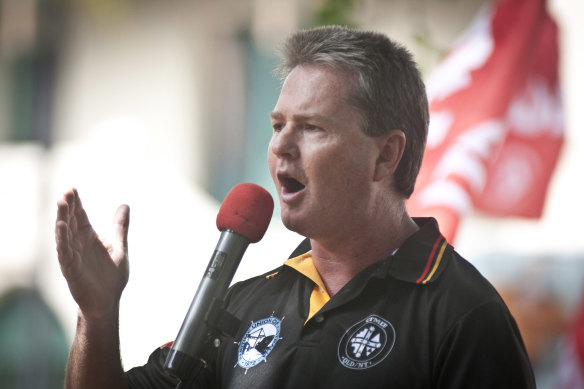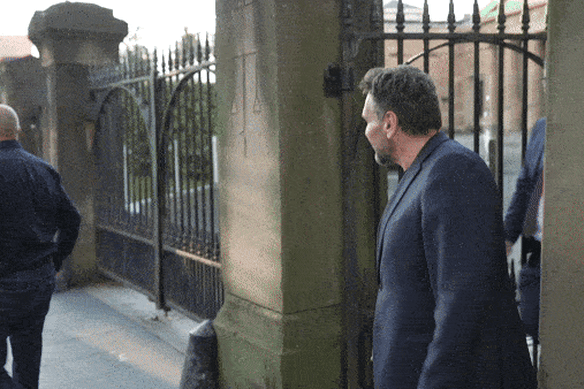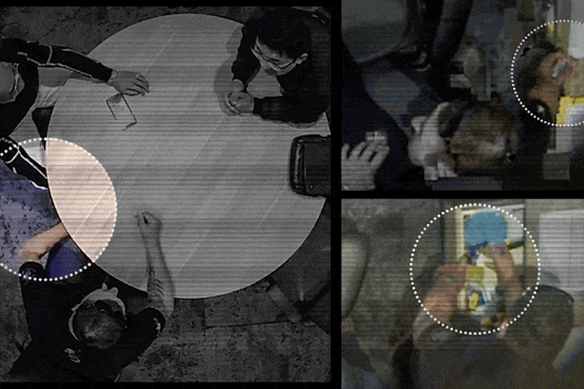By Mathew Dunckley and Michael Bachelard
When investigative reporter Nick McKenzie called long-time CFMEU boss John Setka in July this year with proof of the deep corruption and cronyism infecting his union, Setka really only had one choice. He quit the job he’d held for 12 years.
But the spectacular implosion of the construction union spurred by the Building Bad series, published this year, did not come out of the blue: it built on work over 18 years by McKenzie, Ben Schneiders, David Marin-Guzman and other reporters.
The reporting that put the union into administration, and which on Tuesday was acknowledged with a Gold Walkley, was a final emphatic shove that – after almost two decades of work and dozens of stories and revelations in this masthead and others, two Commonwealth royal commissions and several police investigations – finally brought down the union’s rotten structures.
The history
In 2006, just months after he started at The Age as a young investigative reporter, McKenzie worked on an in-depth investigation into a troubled construction site in Melbourne.
The asbestos-ridden power station site – located, oddly enough, directly across the road from the then offices of The Age – had been derelict for 25 years, the plaything of a number of shonks and shysters.
Within the story about dodgy business dealings, Russian purchasers and ripped-off demolition crews, McKenzie revealed the deep links between Melbourne gangland figure Mick Gatto and a then young construction union organiser by the name of John Setka.
“I had a little problem on a site years ago that I rectified for someone,” Gatto was quoted as saying, “and through meeting that [union] organiser – and I’ve got a funny feeling that it was John Setka – it just snowballed.”
Part of that, McKenzie revealed, was the corporate links between Setka’s then fiancee and Gatto’s then business partner – links dismissed by all parties at the time.
The wall of denials and obfuscation did not stop there, but neither did the investigations of the CFMEU in Melbourne and Sydney.
In 2014, McKenzie and his co-authors revealed a startlingly familiar fact: “Officials from Australia’s powerful building unions are being bribed by corrupt companies that need their support to win multimillion-dollar contracts.” The bribes involved labour hire firms, traffic management, scaffolding, crane and building companies, several of which were connected to bikies and organised crime figures. On that occasion, a Victorian union organiser was forced to resign.
Those revelations, among others, prompted an Abbott government royal commission into the unions and, the following year, a police investigation. Very little came of the official probes. Setka was exonerated on blackmail charges brought against him.
Only after this masthead, led by crucial and sustained reporting from Schneiders, published details about Setka’s personal life, including domestic abuse allegations made by his then wife, and critical comments about domestic violence campaigner Rosie Batty, did attention again return to the powerful union leader.
Those revelations prompted calls from then premier Daniel Andrews for Setka to apologise to Batty, and he was convicted of domestic violence offences.
The charges included harassing Ms Walters and breaching intervention orders after he made more than 25 calls and sent 45 text messages in which he called her a “weak f---en piece of s---” and a “treacherous Aussie f---en c---” and a “f---en dog”.
Despite calls from ACTU secretary Sally McManus for him to quit the union, he remained its powerful secretary.
In July this year, that suddenly changed.
The revelations
Even before the first part of the joint Building Bad investigation – from The Age, The Sydney Morning Herald, The Australian Financial Review and 60 Minutes – had published or aired a single word John Setka had seen enough.
On the evening before scheduled publication of the first story in the series, Setka announced he would resign immediately as head of the union’s Victorian branch. He did so after the union had issued a statement defending its conduct in response to a series of questions from the joint investigation.
The next day the first instalment of the investigation was published. Featuring secret surveillance and new audio, it revealed how bikies, criminals and underworld figures had infiltrated the building industry, including on large publicly funded projects.
The investigation unearthed a raft of misconduct allegations involving Setka and the CFMEU. It detailed how underworld figures who have served as some of Australia’s highest-ranking bikie bosses, including a former Mongols national vice president and two men who held the top post at the Hells Angels as chapter presidents, along with several bikie gang associates, have been parachuted into union delegate positions, including on publicly funded projects.
The revelations sparked immediate political repercussions. Later that same day, Prime Minister Anthony Albanese welcomed Setka’s departure, saying the behaviour detailed in the investigation had no place in the union movement. The premiers of Victoria and NSW both also expressed concern, while South Australian Premier Peter Malinauskas referred the matter to his state’s police.
The next day the investigation published video recordings of a union official abusing a company owner on a $700 million state and federally funded project and of Setka delivering a suitcase with “Leo the dog” written on it to a whistleblower.
The then federal workplace relations minister, Tony Burke, responded by saying he would consider deregistering the union in response to the “absolutely abhorrent” behaviour.
Business leaders called for a judicial inquiry and reinstatement of the Australian Building and Construction Commission.
On that Sunday night, 60 Minutes screened its special investigation revealing, at the same time as this masthead, that a union fixer had offered a place on a large publicly funded project in return for a kickback. “Everyone eats,” he was recorded saying.
The joint investigation also published the story of Ben Nash, a young man who died after suffering what his mother said was terrible bullying at the hands of the CFMEU.
The fallout
By Monday morning momentum on action against the CFMEU was under way. Labor branches around the country were moving to refuse donations from the construction division, one of the party’s biggest financial supporters.
The national branch of the CFMEU put the Victorian branch into administration, seizing control of its most militant arm.
ACTU chief Sally McManus held a tense press conference at which she decried the union’s leadership and called for all those implicated to step aside.
Victorian Premier Jacinta Allan also faced the press, saying she would ask for the CFMEU to be suspended from the Labor Party.
At times stumbling in response to questions from Nick McKenzie, the premier said she would also request a review of workplace agreements.
As Ben Schneiders wrote later that day, the response from the union and policymakers probably did not go far enough.
“Setka has left his union looking more like a bikie gang than a vitally important trade union. Building workers deserve much better,” he said in an analysis.
After two more days of intensifying pressure, Tony Burke announced he would seek to have the CFMEU placed in the hands of an independent administrator rather than deregister the union.
McManus backed the move and the ACTU suspended the CFMEU from its place on the peak body’s executive.
Burke also asked the Australian Federal Police to look at the involvement of organised crime on building sites.
Allan was left scrambling to explain why she had not acted on specific warnings from an Indigenous labour hire company targeted by the CFMEU.
CFMEU national secretary Zach Smith rejected an assertion during an ABC radio interview that Setka had shamed the union.
Against this backdrop there were continuing revelations from this masthead, including that female federal and state MPs had privately expressed their support to Setka after he was accused of criticising domestic violence campaigner Rosie Batty.
On a single day that week the CFMEU faced three different federal court hearings over separate allegations of intimidation, bullying, abuse and death threats in Victoria, Western Australia and Queensland.
The next day more than 20 CFMEU officials were stood down but also before the end of the first week of the scandal, some union leaders signalled they would not go without a fight.

Former CFMEU Queensland and Northern Territory divisional secretary Michael Ravbar.Credit: Robert Shakespeare
Queensland CFMEU boss Michael Ravbar claimed Albanese had “panicked and soiled the bed” in trying to appoint an administrator across the CFMEU’s east coast branches.
The trouble in Sydney
Decades of allegations about CFMEU misbehaviour were not confined to Setka and the union’s Victorian operations.
Over the years, McKenzie and investigative reporter Kate McClymont had also detailed serious allegations related to the NSW branch of the union, and its dealings with developers, including the disgraced developer George Alex.

Construction boss George Alex, 53, has been found guilty of a conspiracy to defraud the Tax Office of $10 million in what prosecutors described as a complicated “revolving-door” scheme.Credit: 60 Minutes
Alex, who with four others was recently found guilty of conspiracy to defraud the Tax Office of more than $10 million over two years, had also boasted to co-conspirators about how the union would not touch his firm because of the “kickers” – corrupt payments – he made to the union.
Meanwhile, the Building Bad series had revealed video evidence played in court of CFMEU NSW boss Darren Greenfield appearing to accept a $5000 wad of cash in his office.
The vision was filmed on June 19, 2020, and appears to show what police allege is a building company owner seeking union support reach into his pocket and remove a wad of cash he then passes under a table to Greenfield.

Images show Darren Greenfield allegedly taking a wad of cash under a table (left) and then putting it in an office drawer (right).Credit: Fairfax Media
About 10 minutes later, the camera captured images of Greenfield placing the wad in his office desk drawer.
Greenfield and his son, Michael, the branch’s assistant secretary, both face corruption charges that have not been tested in court and which they both deny.
Neither man immediately resigned from the union, though Michael did so a month after the story was published, and Darren lost his job when the union was eventually put into administration (see below).
NSW Premier Chris Minns, however, responded to the reporting by removing the CFMEU from its Labor Party affiliation, and stopping all donations.
The battle intensifies
As revelations mounted about the union’s conduct, the federal government gazumped a court challenge from the union and secured legislation that would put it into administration.
It appointed Mark Irving to the job.
The now former leaders from the Victorian and NSW CFMEU branches became features at large public rallies.
The union movement splintered, with some unions, notably the Electrical Trades Union, siding with the CFMEU, arguing that governments should have no role in picking who runs unions.
The Greens have sided with those unions putting a new political element into the debate.
The ACTU stood fast, arguing the CFMEU’s conduct was beyond the pale.
Setka launched a foul-mouthed tirade on a Victorian building site and gave an exclusive interview to Channel Seven, insisting he had not done the wrong thing.
Irving told this masthead and 60 Minutes in an exclusive interview, after a fortnight in the job, that the corruption and coercion infecting the CFMEU was even worse than publicly reported.
He vowed to pursue dishonest unionists and employers who had contributed to a culture of fear and intimidation in the industry.
“People should not have to turn up to work with menacing conduct as part of a business model of an employer or of a union. That sort of menacing conduct has no role in industrial relations in the construction industry or anywhere in Australian society,” he said, adding it would take time to set the union straight.
Shortly after that, the Victorian government introduced its long-awaited anti-consorting laws that would allow police to prevent bikies from entering government worksites.
By mid-October death threats were reported against both Irving and McManus. On Tuesday McKenzie reported that security was being beefed up at CFMEU offices amid fears of retaliation from bikies.
And the story is not done.
Start the day with a summary of the day’s most important and interesting stories, analysis and insights. Sign up for our Morning Edition newsletter.